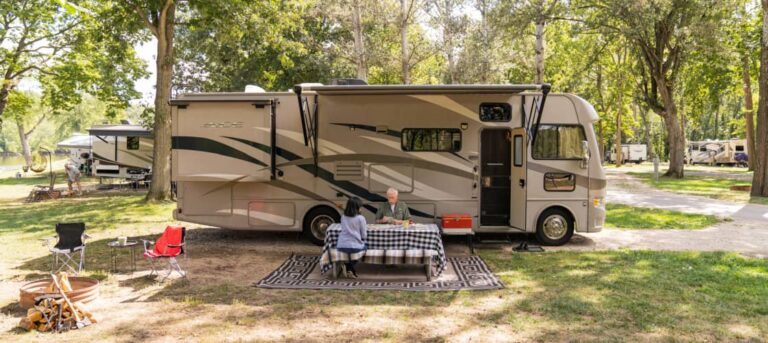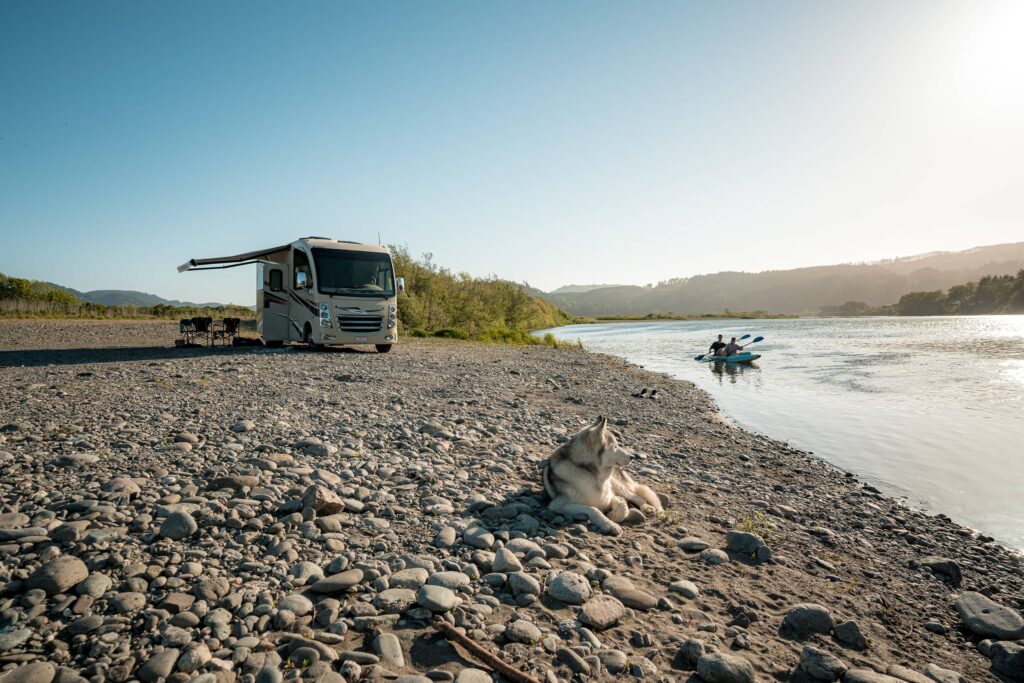
If you’re trying to decide what class of RV or trailer will suit you and your family best, you may want to consider the Class A motorhome. This rig is the largest of the non-towing options. It’s a great pick if you’re traveling with a big group, or if you like some extra room or high-end amenities.
Class A RVs: What You Need to Know
Class A motorhomes are the large, bus-shaped rigs you might associate with celebrity tour vans or exclusive motorhome resorts. They range from about 20 feet to 45 feet in length and can sleep up to 10 passengers – sometimes even more – depending on their configuration.
A Class A motorhome can run on a gasoline or diesel engine, and may include one or more slide outs to increase the interior space while camping.
Class A Motorhome Amenities
Class A motorhomes often feature luxurious amenities and furnishings, including full-sized kitchen appliances, plush leather pull-out bed sofas, large closets, and sometimes even washing machines and bath tubs. Some larger Class A motorhomes can also have a fireplace.
A Class A RV is usually fully equipped for offgrid camping, with a propane-fueled generator and regular utility connections. Most Class As will draw at least 30, and up to 50, amps of electricity, whether you’re hooked into shore power or running your generator. Class A RVs also come with built-in plumbing systems including gray, black, and freshwater holding tanks of up to 50 gallons each, as well as water heaters.
The exact features you’ll get depends a lot on the specific make and model of vehicle you rent or purchase. Different manufacturers specialize in different setups and uses, and most offer a wide range of layouts.
| Category | Class A Motorhomes |
| Size | 26 – 45 feet |
| Weight | 13,000 to 30,000 pounds |
| Mileage | 6-13 miles per gallon |
| Storage | Moderate to extensive |
| Sleeping Capability | 4-8 adults |
| Extra Amenities | Multiple slide-outs, full bathrooms with separate showers, full kitchen facilities, residential-style furniture, entertainment systems, washer/dryer units, ample onboard plumbing facilities, large generators |
| Price Range | $80,000-$500,000+ new |
Class A Diesel Pushers
If you’ve been researching Class A RVs, chances are you’ve heard certain rigs referred to as “diesel pushers.”
Class A RVs can be run off either gas or diesel engines. Diesel is a denser fuel source — so although it’s often more expensive per gallon, you get more combusting power in each ounce of liquid than you do with gasoline. That can mean a more efficient engine. This is important when you’re talking about a vehicle that may weigh as much as 30,000 pounds fully stocked. For this reason, many luxury Class A RVs are built with diesel engines in the rear of the vehicle, which is why they’re known as “diesel pushers.”
Some manufacturers exclusively create Class A diesel RVs, while others allow consumers to choose between gas and diesel versions of their rigs. While a diesel configuration may come with a larger upfront expense, many campers feel confident they function better in the long term. Many RVers also think diesel pushers make driving much easier and more efficient, especially in hilly or mountainous areas with steep grades.
Class A Motorhome Manufacturers

The best way to decide on an RV is to check out different models in person. That way, you have a first-hand experience of what each manufacturer has to offer.
Finding the right RV for you and your family takes time, patience, and research. One of the very best ways to see and experience as many motorhomes as possible in a short time is to attend an RV show or expo. You’ll be able to walk through rigs from many different manufacturers and dealerships, which means you’ll get a feel for the people from whom you’d be purchasing your rig. In many ways, that relationship is just as important as the specs of your prospective vehicle, so be sure to take your time during your walkthrough and ask as many questions as possible!
You can find a variety of options on our list of RV events organized by state. Chances are, there’s a fun and useful opportunity coming up soon somewhere near you… or in a destination you’ve been meaning to visit!
Below, we’ve listed and described some of the most commonly known RV manufacturers that deal specifically with Class A models. But you can also check out our giant guide to even more RV manufacturers, including those that make travel trailers and other classes.
Here are a few outstanding Class A manufacturers you may want to consider:
Newmar Corporation
When it comes to luxury motorhomes, Newmar Corporation is one of the best-known manufacturers in the business. It also has the distinction of offering some of the priciest rigs you can find, with certain optional build features pushing custom-designed models as high as a million dollars.
That might sound like a whole lot to spend on an RV, but with Newmar, you definitely get what you pay for. These RVs are crafted with a painstaking attention to detail and build quality which keeps them in running order for many years and camping trips to come.
Although a brand-new Newmar might be outside of most of our budgets, because these RVs hold their quality for a long time, buying a used one is a great option for getting an amazing deal on an amazing rig. Their Class A coaches come in both gas- and diesel-powered options, and are often available on RVtrader and other used RV classifieds lists.
Thor Motor Coach
Well-known for its high-end line of Class A diesel motorhomes, Thor Motor Coach also creates Class Cs as well as Class B vehicles. Their Class As include the Hurricane, the Challenger, the Mirimar, and their Palazzo. The Aria, Venetian, and Tuscany coaches are exclusively diesel-powered.
Tiffin Motorhomes
Known for high quality and craftsmanship in all of its products, Tiffin Motorhomes creates Class A rigs as well as high-end Class Cs. Their coaches are built with both gas and diesel engines, and are stocked with top-quality amenities and furnishings to complete their ample living spaces.
Class A RV Rentals: Saving Money Without Sacrificing Class
When it comes to renting a Class A motorhome, the sky-high per-night prices can stand in the way. Given the amenities and conveniences of these RVs, some of the large, nationwide dealerships charge as much as $300 per night for a Class A diesel pusher. Factor in other costs of your trip, including campsite accommodations and fuel, and you’ve got a pricey vacation.
Renting a Class A Motorhome With RVshare
Renting through RVshare is a great way to experience the Class A camping lifestyle without paying a traditional rental agency’s Class A prices. That’s because when you rent directly from an owner, you don’t have to pay for all the overhead business expenses like keeping the lights on at a dealership floor or a customer service team. The peer-to-peer market simplifies your rental experience and makes it into a one-on-one relationship between you and a real, live RV owner.
Tips for Camping in a Class A Motorhome
Here are a few things to consider if you’re going to be camping in a Class A motorhome.
Know the dimensions
Since Class A motorhomes are some of the largest out there, you’ll want to know your rig’s dimensions before you embark on a road trip. Some campgrounds and roads, have length or width restrictions that you’ll need to be aware of. You’ll also want to know the height of your rig before going under bridges or overpasses, and before attempting to park in many parking garages. Be aware of trees, power lines, and other obstacles above you as well.
Budget for gas
Hefty Class A motorhomes aren’t exactly known for their efficient gas mileage.
The largest Class A motorhomes may not get more than four to six miles per gallon. That means a 2,500-mile cross-country road trip, at a fuel price of $3 per gallon, might cost as much as $1,875. That’s a lot of cash to pour into your gas tank! You may also want to consider carbon emissions and eco-friendly travel styles. You can help offset your footprint by implementing these simple tips for making your RV trip greener.
Take it slow
You may want to take some time to practice driving a Class A motorhome for a bit before taking it out on the road for a long trip. Consider a camping trip nearby, as a practice run before a longer vacation. You can also practice driving your Class A motorhome in an empty parking lot to get a feel for how it handles.
You’ll also want to literally take it slow as you drive the motorhome. You’ll want to go slowly and know where your blind spots are. Also, the sheer size and weight of your rig means you may not be able to go high speeds on freeways. You’ll want to factor the extra time it takes to drive into your road trip scheduling, so you have an accurate idea of how long your trip will take.
Arrive in the daytime
The first few times you camp, you may want to plan to arrive while it’s still light out. That will make it a lot easier to see what you’re doing as you set up. Give yourself plenty of time to set up, and plan a relaxed afternoon and evening.
Plan off-days
Driving a Class A motorhome can be exhausting! You need to stay alert on the road, and you’re watching many more things than you do in a smaller vehicle. If you can, plan a day of driving followed by a day of rest. This also ensures you enjoy the journey as well as the destination!
Hopefully, this article has helped you to understand Class A motorhomes better and to consider whether they’re the best fit for you. You can browse Class A motorhome rentals on RVshare to get an idea of what’s available.

